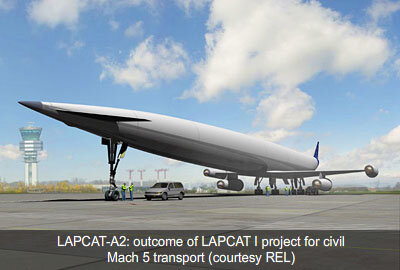LAPCAT II
LAPCAT II is a logical follow-up of the previous, co-funded EC-project LAPCAT I, whose objective was to reduce the duration of antipodal flights (that is, flights between two diametrically opposite points on the globe) to less than two to four hours. Among the several vehicles studied, only two novel concepts – for Mach five and Mach eight cruise flight – are retained in the new program. The project, co-funded by the European Commission under the theme of air transportation, will last for four years and involves 16 partners representing six European member states.
Starting from the available Mach five vehicle and its related, pre-cooled turboramjet developed in LAPCAT I, the assumed performance figures of various components will now be assessed in more detail, i.e.:
-
- intake design and performance
- environmentally friendly design of combustor
- nozzle design and performance
- structural analysis
This will lead to an updated overall Mach five vehicle performance, allowing the definition of a detailed development roadmap.
Although the cruise flight of the Mach eight vehicle – based on a scramjet – seems feasible, the fuel consumption during acceleration requires a large fuel fraction, severely affecting gross take-off weight. Initial studies of a first stage rocket ejector concept gave poor range with large take-off mass. Integrated design of airframe and engine throughout the whole trajectory is now the prime focus to guarantee an optimal design in terms of range and flight time. Different concepts will be re-assessed and optimised to achieve a final Mach eight concept. Both turbo- and rocket-based engines will be investigated to ensure better performance and fuel consumption during acceleration and cruise. Important points that will be addressed to realise these goals are:
- proper development and validation of engine-airframe integration tools and methodology
- high-speed airbreathing cycle analysis
- off- and on-design behaviour of engine and airframe
- dedicated experiments to evaluate the design at various operation points in the fields of aerothermodynamics, intakes, combustion and nozzles
High-Speed windtunnels for aerodynamic and combustion experiments
- H2K blow down facility at DLR-Cologne Courtesy DLR
- HEG shock tube tunnel at DLR-Göttingen Courtesy DLR
- ITLR connected tube at University of Stuttgart Courtesy ITLR
- LAERTE connected tube at Onera-Palaiseau. Courtesy Onera
- F4 Blow down tunnel at Onera- La Fauga Courtesy Onera
The dedicated experiments will form the basis for validation of advanced design tools. These numerical tools will give better confidence when proposing a fully integrated vehicle that complies with the mission goals. In particular, nose-to-tail computations should give the simultaneous solution and interaction of an operational propulsion unit and the vehicle aerodynamics. A roadmap towards the final vehicle design will be laid out with a step-wise approach to future developments.
Finally, for vehicles flying at high speeds and high altitudes, limited knowledge is available on their environmental impact. The influence of NOx and H2O on the ozone layer and the formation of contrails with its direct and indirect effects will be investigated for both the Mach five and Mach eight vehicles.









